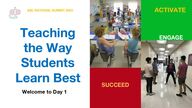
Return to flip book view
Message SUCCEEDACTIVATEENGAGETeaching the Way Students Learn BestAction Based LearningABL NATIONAL SUMMIT 2023Welcome to Day 1
ACTION BASED LEARNING
Action Based LearningABL NATIONAL SUMMITWhat is Action Based Learning?
Brain-Based & Brain-Compatible Teaching Strategies• Lessons presented in a brain compatible way• Anchors learning• Increases memory and recall• ABL Classroom management
Self-ManagementProblem SolvingPhysical Fitness/ Cardiovascular EnduranceEye Hand/Eye Foot Coordination/Motor SkillsVisual Development/ Rhythm/Tactile LearningCross the Midline/Body in Space/Balance 12 Foundations of Learning Readiness
Fundamental Foundations of LearningFoundation Purpose• Cross Lateralization • Body in Space• Balance • Visual Fitness• Rhythm • Motor Skills• Coordination • Physical Fitness • Cardio Fitness• Problem Solving • Mindfulness• Brain Organization• Vestibular, Proprioceptors• Balance• Encode symbols• Beat Awareness, Beat Competency• Fine, Gross, Locomotor• Eye Hand/Eye Foot, Tracking• Strength and Endurance• Neurogenesis• Academic Reinforcement• Social/Emotional
Why Action Based Learning is needed?
Neuroscience supports Activity throughout the dayCDC Report May 2014
Why do we exercise??Better Health?Eliminate Obesity?Prevent Disease?Get into a Speedo or Bikini?
Exercise benefits the BRAIN firstExercise changes the brain at a MOLECULAR LEVEL• Brain fuel is oxygen and glucose• Neurogenesis and Cathespin B• Secondary dendritic branching (memory)• Neurotransmitters• BDNF
Sitness vs. FitnessWe are made to MOVE
ActiveSittingSitting kills brain cells
Different BrainsDifferent LearnersTeaching the whole child
We teach different brains and different learners We teach ALL brains and ALL learners!
What does the Research Say?
Exercisemakes you SmarterBDNF floods the brain Aids mental sharpness and the ability to learn and memorizePeople with ADHD have lower levels of BDNFBDNF increase could alleviate the symptoms of ADHDDartmouth Michaels Hopkins 5/2012
Aerobic Exercise increases Learning ProcessesBRAIN AFTERSITTING QUIETLYBRAIN AFTER 20 MINUTE WALKAverage composite of 20 students brains taking the same testHillman Sept. 2013
Second Language Learners• Dr. Charles Hillman 2014• Children who are physically fit have a faster and more robust neuro-electrical brain responses during reading.• Compared to less fit peers resulting in better language skills• https://www.teachermagazine.com.au/articles/action-research-physical-activity-and-student-writing?platform=hootsuitePhysical Fitness results in better language skills
Obesity impacts academic successImpairs executive functioning
• “Obese children are slower than healthy weight children to recognize when they have made an error and correct it.”• “Weight status not only affects how quickly children react to stimuli but also impacts the level of activity in the cerebral cortex during action monitoring, a necessary skill for academic success”• University of Illinois Dr. Hillman 2014• “Obese brains appear to be 10 years older” 2016 U Tex
Teaching the Brain in PovertyExercise directly counterbalances the effects of poverty
• Deprivation• Toxic Stress• A chronic and debilitating condition that results from multiple adverse synergistic risk factors• Affects the mind, body and soul
HomeostasisHealthy Balancevs. AllostasisInability to Regulate Emotions
Learn the Same, but Remember Differently• Judgments• Planning• Regulating impulsivityFrontal Lobe• Executive function• Cognition• AttentionPrefrontal Cortex• Learning• Working MemoryHippocampusAcute Stress shrinks neurons in brain
Exercise counterbalances ill effects of povertyStressed neurons• Generate a weakersignal• Handle less blood flow• Process less oxygen• Extends fewer connections to nearby cellsActive neurons• Generates a stronger signal• Increases blood flow• Processes more oxygen• Extends more connectionsto nearby cells• Grows new brain cells• Reduces stress/cortisol• Improves mood
Who benefits from Action Based Learning?
Action Based Learning translates neuroscience research into classroom practice for ALL learners
Best Elementary
Crossroads High School
Heflin elementaryEarly Bird Action Based Learning group-Office referrals on days students participated in Early Bird Group in ABL lab. 75%
Heflin elementaryHeflin pairs academic intervention with ABL, students raised scores at a faster rate than those who did not receive ABL.Around 85% exit out of the program.
When To UseAction Based Learning?
Where is Action Based Learning Effective?
TangibleABL is…Intangibleand
Intangible• A belief that movement enhances learning• ABL is a program, not a curriculum• Very little cost involved• A teaching strategy that incorporates movement throughout the day• ABL teaching and facilitation skills set us apart: Celebrate, Process, Apply
Tangible• Action Based Learning Labs• Primary ABL Labs PreK-2• Body Brain Adventure Grades 3-5• NeuroNasium Grades 6-12
Primary Lab
Body Brain Adventure
NeuroNasium6th-12thgrade“Brain Room” at Crossroads
The BRAIN is only as Healthy as the BODY that Carries it!Healthy, Active KIDS make better LEARNERS